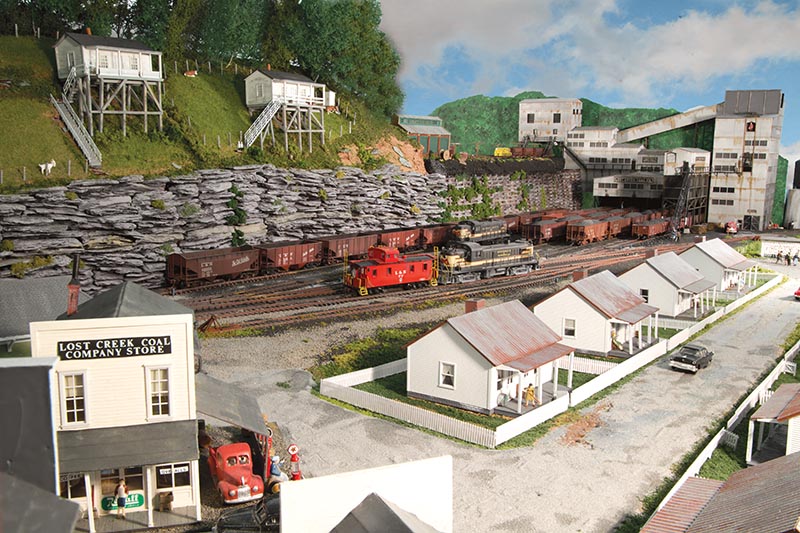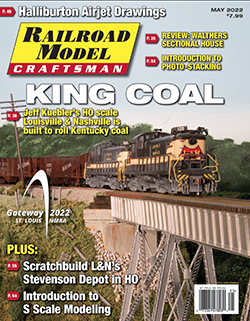 By Jeff Keubler/photos by Dan Munson
By Jeff Keubler/photos by Dan Munson
When I grew up in Louisville, Ky., there were many railroads around, but no other railroad could draw me to modeling more than Louisville & Nashville. Chartered in 1850, the railroad built out from Louisville and grew into a 5,000-mile system linking the coalfields of Appalachia with the major cities in the South and ports along the Gulf Coast.
Some of my earliest memories were seeing the evening run of a passenger train heading south in the South Louisville Yards from atop the shoulders of my grandfather. My grandfather later took me to the Kentucky Railway Museum to see the steam engines and ring the bell from the cab of L&N 152. I witnessed the arrival of second-generation gray-and-yellow diesels from the backyard of my great-grandmother’s house. Modeling the L&N was the easy choice, but where and when to model it would not be easy.
I joined the L&N Historical Society in 1988 and my eyes were opened to a whole new world. The L&N did indeed exist beyond my suburban surroundings and went to 12 other states too. There were a great deal of exciting and distant places such as Atlanta, Memphis, New Orleans, and St. Louis where great stations, bridges, and terminals abound. But as I turned the pages of the books and magazines I had acquired, the era of big steam and early diesels were the most enchanting. The mighty L&N M-1 class 2-8-4s were the most handsome locomotives I had ever seen. Narrowing down my modeling era to the period between 1942 and 1956, I chose the year of 1955 since the “Big Emmas” were still in action and could be seen on coal drags as well as the fast freights. The Berkshire-class locomotives were generally assigned to the Eastern Kentucky region, lugging loaded coal drags northward to Cincinnati from the Eastern Kentucky and Cumberland Valley subdivisions. This further narrowed the area to be modeled.
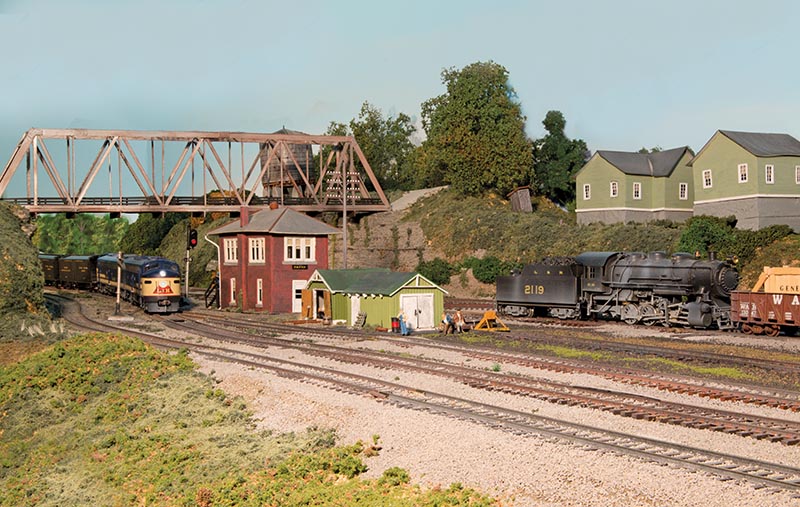
ABOVE: Patio Tower guards the intersection of the C-C and EK Divisions and also controls the yard movements of the L&N trackage there. The Flamingo glides by the tower and a “C” Class 0-8-0 switcher, 2119, holds down the 1st trick yard job, sorting cars for the EK branch and Winchester, just a mile to the north. All the buildings are scratchbuilds except for the water tank.
About that time an L&NHS magazine article featured Winchester, Ky., during the steam era. The problem was solved. Patio Yard in Winchester included a picturesque tower and bridge, a level crossing, and an interchange with the Chesapeake & Ohio only a mile north of it. The Eastern Kentucky (EK) Subdivision joined the Cincinnati-to-Corbin double-track main lines at Patio Tower, where an endless parade of northbound loaded and southbound empty coal trains would pass daily. M-1 helpers would drop off the rear end of their trains at Patio from shoving loaded coal up from Ford, Ky. Ford’s helper pocket, dual through-truss bridges over the Kentucky River, and two tunnels were also a sight to behold. This area was perfect for modeling. Ravenna was the marshaling yard where the coal was washed, sized, and oiled before it was assembled into 100-car trains and moved north.
Naturally, L&N maintained a locomotive terminal there with a coaling tower and a roundhouse. Ravenna was another place just begging to be modeled. The Red River Viaduct, the highest bridge on the L&N system, was also on the EK Sub, located between Patio and Ravenna. Just one look at old photos of heavy freight and passenger trains rolling over that awesome bridge left little doubt in my mind it would be included on my model railroad.
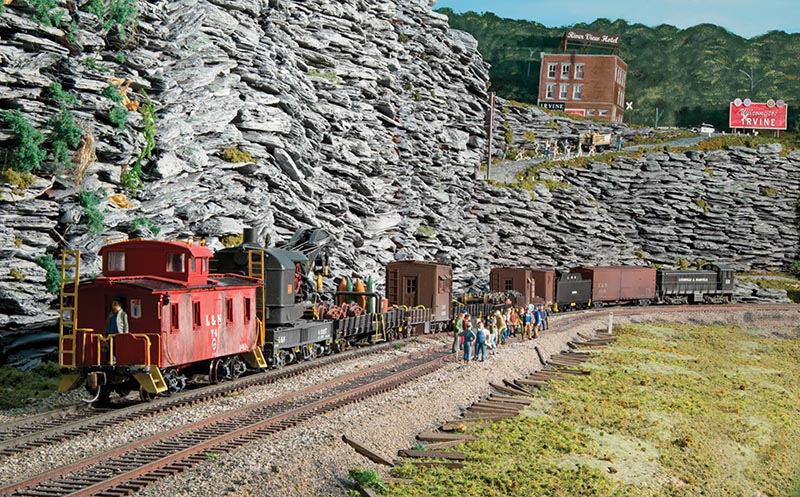
ABOVE: A section gang works a tie replacement project on the southbound main while a wreck train uses the opposite main returning from a derailment per the dispatcher’s orders. Tichy cars make up many of the cars while the rock wall is made from painted pine bark nuggets and secured with latex caulk.
Building the Layout
I started building some of the rolling stock and structures for my future layout in the late 1980s when I still lived in an apartment in Kentucky. A move to Maryland in 1994 gave me an opportunity to start a traditional “around-the-walls” shelf layout in a ranch-style house with an open basement.
I built Patio Yard and most of the buildings in it and had a double-track main line working well with six staging tracks. Pretty soon I had coal, passenger, and general freight trains snaking around the room. Another move in 2002 to our present house would see me cut up the layout into manageable sections and await a future rebuilding.
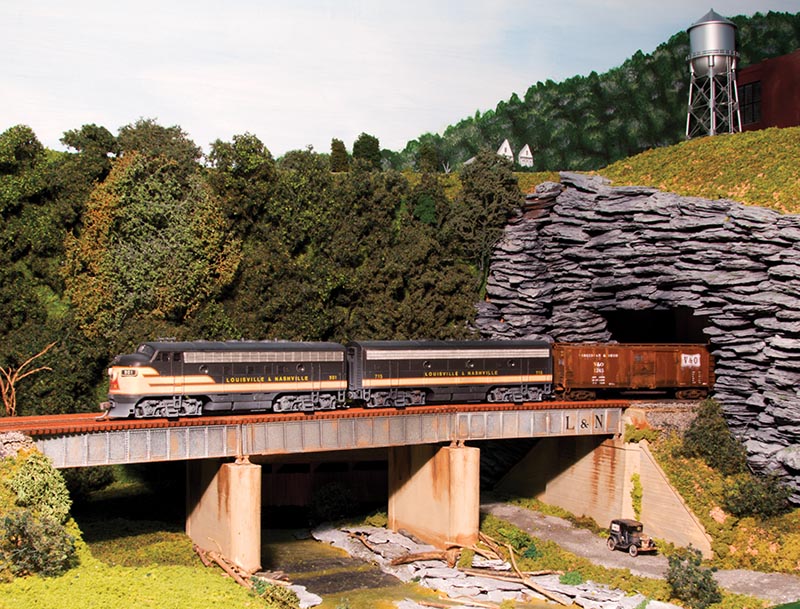
ABOVE: F7A and B locomotives lead a northbound manifest freight across the Twelve Mile Creek bridge which marks the halfway point up Winchester Hill from Ford, Ky., on the L&N’s Corbin-Cincinnati Division double-track main line.
I continued to build rolling stock and structures by the dozen but made little progress on the new basement for about five years. I started the layout room with Patio Yard in three sections. Each of the studs in the walls would have to line up exactly with the wood supports already existing in those yard sections. I had planned a cantilevered upper level at chest height and a lower level underneath with two more towns on the C-C Division and a huge staging yard.
I had learned a few good lessons from my Maryland layout, the most important being that the lighting was poorly planned for an “around-the-walls”-style layout. The centered, drop-ceiling fluorescent fixtures only caused shadows when you stood between them and the trains. The new basement would get valances with purpose-designed lighting to give the layout the best light for viewing the details. Also, the layout should not be able to be viewed from one place; walls and mountains would give you the feeling you actually went somewhere this time…


